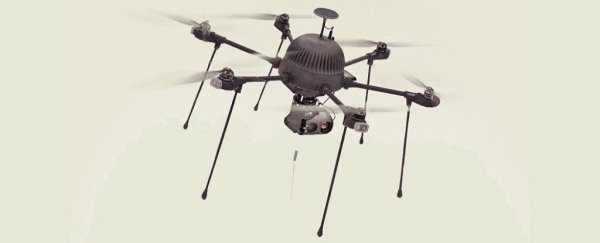If you've ever had a bit of a play with a consumer drone unit you'll know that their power supplies don't necessarily last all that long. After spending some time in the air, you need to keep an eye on your device's battery levels (in addition to watching out for trees) to make sure things don't come to an abrupt, ground-smacking end.
The PARC (Persistent Aerial Reconnaissance and Communications) from drone-maker CyPhy Works, doesn't suffer that particular shortcoming, however. This uniquely powered drone can stay in the air indefinitely (although 100 hours is the maximum recommended operating time) thanks to its proprietary microfilament system, which is effectively a specialised power cord that extends from the ground to the airborne unit.
"It's basically a robot with unlimited time-of-flight," said Helen Greiner, the founder of CyPhy Works, speaking this week at the EmTech 2015 conference in Cambridge, Massachusetts, as reported by Will Knight at MIT Technology Review. "You send it up and it stays there."
While the microfilament system means the drone is pretty much tethered in one location, for its intended use case that's not so much of a problem: unlike free-ranging long-distance drones, the PARC is primarily designed as a long-term surveillance unit and has been used by the US military for this very purpose, where it can keep an eye over ground bases or monitor movement from afar.
This week however CyPhy Works announced it had received clearance from the US Federal Aviation Authority (FAA) allowing its customers to fly the device for commercial purposes. So, while you won't see Amazon or Google using the PARC to deliver packages any time soon – the latter said recently it intends to begin drone deliveries as soon as 2017 – it's quite possible you might see the unit operating for other sorts of outdoor surveillance and security tasks.
We can imagine TV networks would love the idea of a long-endurance drone that can monitor and film extraordinary incidents for hours or days on end without needing to land and swap batteries. Or building managers might be attracted to having some eyes in the sky for value-added security to complement ground-level cameras and security systems.
In addition to carrying electricity up to the drone to keep it operational in the air, the microfilament cable also acts as a data cable, ensuring that the PARC's surveillance recordings (high-definition video, also recordable in night-vision mode) can securely and unhackably make it down to its ground level control station – not that the independent drone needs piloting (it's fully self-sufficient in the air up to an altitude of 150 metres).
But what if the cable comes lose, severing the PARC's power supply? Fortunately the unit comes equipped with an internal battery for just these very emergencies, meaning even if the drone gets unplugged, it can safely fly down to make an independent landing.
